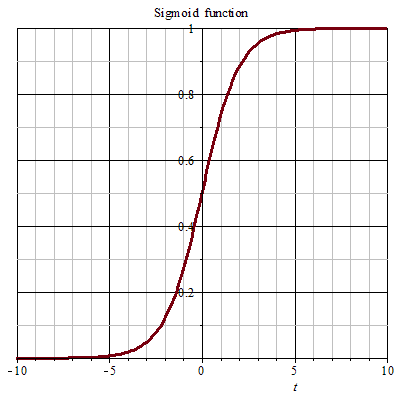Sigmoid和Softmax使用区别(Tensorflow)
一直都对这两个函数的一些概念理不清楚,今天就整理一下,结合吴恩达老师和李沐给出的Tensorflow的coding过程,一并整理厘清概念和这两者的区别。
Sigmoid
Sigmoid通常用于逻辑回归Logistic Regression的二分类中,output出一个概率值(比如:预测一张图片是一只猫的概率)。它的公式为: \[ \frac{1}{1+e^{-z}} \] 图示为:

特点:y的值是介于[0,1]之间的,而x是负无穷到正无穷的。x=0时,y=0.5。
LR的网络结构为:

在将Sigmoid用于LR任务中时,模型的输入是一个特征向量X,这时的loss function使用:

这里不会使用MSE,原因是:

loss function是在单个训练样本中定义的,它衡量的是算法在单个训练样本中表现如何,为了衡量算法在全部训练样本上的表现,需要定义代价函数(cost function),在LR中代价函数即为对m个样本的损失函数求和再平均:

虽然有这么多计算步骤,但是在tensorflow中,我们并不需要自己计算sigmoid后的值a,然后将a和y放到J函数中计算中整体的cost,只需要一个函数就可以帮助我们实现。
tf.nn.sigmoid_cross_entropy_with_logits(logits=z,labels=y)
注意:上述的z是before the final sigmoid activation的值,也就是还没有传入Sigmoid前,只是经过线性计算后的值。
Softmax
softmax函数是对sigmoid的推广,用于处理多分类的问题。公式:

它的输入是一个向量,输出也是一个向量。不同于Sigmoid的输入(实数),输出(介于0,1之间的概率值)。Sigmoid的输出是一个向量,其中 向量中的每一个元素的范围都在(0,1)之间,它能将一个含任意实数的K维向量压缩到另一个K维向量中。
它在线性模型中的应用方式为:对接最后一层,输出一个向量。

它的loss function是:

其中q为输出向量y的维度。
那么它的cost function J应该是将整个训练集的损失总和: 通常叫做cross-entropy loss交叉熵损失函数

在tensorflow中该过程只需要一个函数来实现:
tf.reduce_mean(tf.nn.softmax_cross_entropy_with_logits(logits = logits, labels = labels))
- 其中logits也是传入softmax激活函数之前的结果,也就是经过线性计算之后的Z
- logits和labels也必须是相同的shape (num of examples, num_classes)
用tensorflow的完整实现即为:
1 | def compute_cost(Z3, Y): |
以上的实现是将里面的计算步骤都展示出来的实现,也就是我们得到Z之后再进一步的得到loss。在李沐的教程中,用tensorflow实现softmax回归使用了更高级的API来实现。
tensorflow keras模块对softmax更简洁的实现
softmax回归的输出层是一个全连接层。因此,为了实现我们的模型,我们只需在Sequential中添加一个带有10个输出的全连接层。同样,在这里,Sequential并不是必要的,但我们可能会形成这种习惯。因为在实现深度模型时,Sequential将无处不在。我们仍然以均值0和标准差0.01随机初始化权重。
1 | net = tf.keras.models.Sequential() |
以上实现的输入是28*28大小的灰度图片,分类类别数为10。
在这里,我们使用学习率为0.1的小批量随机梯度下降作为优化算法
1 | loss = tf.keras.losses.SparseCategoricalCrossentropy(from_logits=True) |